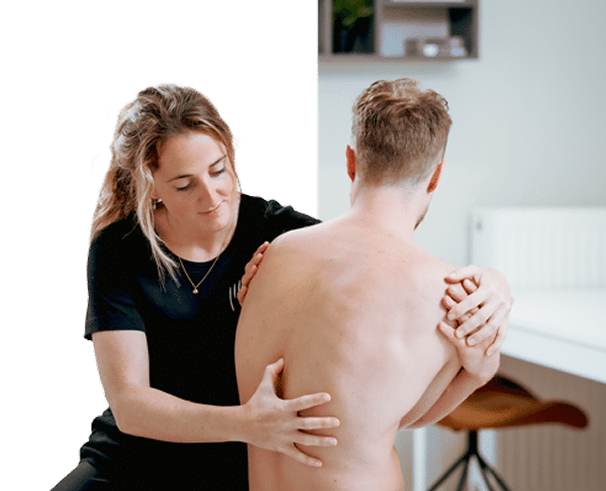Help, I sprained my ankle
A misstep on the sidewalk, an unfortunate move while exercising, or simply walking on an uneven surface – before you know it, your foot flips in or out and then it happens, ankle sprains. This injury is more common than you think and can be quite annoying. A sprained ankle causes pain, swelling, and sometimes a feeling of instability, but fortunately, this injury usually recovers on its own with proper care and attention.
In brief
- What is a sprained ankle? A sprained ankle often results from a wrong movement in which the foot flips inward or outward.
- Symptoms: common symptoms include pain, swelling, bruising and a feeling of instability in the ankle.
- What can you do yourself for recovery? Recovery requires rest, controlled movement, and possibly support with tape or a brace.
- What can a physical therapist do for you? Physical therapy can help restore ankle strength and stability.
- For more serious situations: Medical attention is needed for severe pain, inability to walk, or prolonged symptoms.

What is a sprained ankle?
A sprained ankle, also called a sprained ankle, occurs when your foot flips unexpectedly. In this process, the ligaments around the ankle stretch or partially tear. This injury can be painful and annoying, but is unfortunately common when playing sports, walking on uneven ground, or by simply misstepping.
During the injury, the ankle ligaments become overstretched, causing minor bleeding and swelling. This also explains why a sprained ankle often turns blue and painful.
Causes and symptoms
A sprained ankle usually occurs when the foot unexpectedly flips inward or outward, causing the ankle ligaments to stretch or even tear. The most common causes are:
- Uneven surface: A pothole, curb or stairs can cause your foot to not land stably.
- Untrained muscles or weak ankle ligaments: These increase the chances of your ankle giving out on a wrong step.
- Poor footwear: Inadequate support of the foot can contribute to a sprain.
- Sports injuries: Sports with rapid changes in direction, such as soccer, basketball or tennis, increase the risk.
- Previous ankle injuries: A previous sprain can weaken ankle ligaments, increasing the risk of recurrence.
With a sprained ankle, you may experience one or more of the following symptoms:
- Sudden pain: Especially immediately after flipping the foot.
- Swelling and bruising: These usually occur around the ankle and may move to the toes or heel.
- Instability: The feeling of sinking through the ankle.
- Movement restriction: pain when walking or standing.
Do you have trouble standing on your foot or can’t take more than four steps without help? If so, it is wise to contact a doctor.
Recovery and rehabilitation
A sprained ankle requires a combination of rest, controlled movement and exercises to support recovery.
Right after the injury:
- Cooling: Use an ice pack or ice cubes (wrapped in a cloth) to reduce pain and swelling. Cool for up to 20 minutes at a time.
- Place high: Place your foot higher than your heart to reduce possible swelling.
- Rest and compression: Use a compression bandage or brace for extra support.
The first week:
- Try to walk again as soon as possible, but don’t force anything. Start with small steps and use crutches if necessary.
- Gently move the ankle back and forth to prevent stiffness, but do not spin the ankle in circles yet.
Build up slowly:
- After a week, start light exercises to strengthen the ankle. Consider rolling off your foot while walking and light stretching exercises.
- Sports such as swimming or cycling are ideal for gradual loading of the ankle without the risk of re-swinging.
With this approach, recovery from a mild sprain usually takes 2 to 4 weeks, and you avoid rapid relapse. More serious injuries, such as torn ankle ligaments, can take months.
Medications for a sprained ankle
Medication is often not necessary, but can help with pain control in more severe cases:
- Paracetamol: A safe option to relieve pain. Take this according to the recommended dosage.
- NSAIDs (such as ibuprofen): These can reduce inflammation, but consult your doctor before using them, especially if you have other medical conditions.

What can a physical therapist do for you?
A physical therapist plays a crucial role in the recovery of a sprained ankle, especially with more serious injuries. They can help you with:
- Education and advice: About the severity of your injury and what to expect during recovery, and tailored advice for recovery.
- Targeted exercises: To regain strength, stability and mobility in your ankle.
- Customized treatment: such as taping or using a brace to provide additional support during your recovery.
Together with the physical therapist, you will create a personalized recovery plan tailored to your symptoms and goals. In addition, a physical therapist can guide you in resuming activities or sports so that you minimize the risk of new injuries.
When to seek medical attention?
A sprained ankle usually heals on its own, but sometimes medical attention is needed:
- If you cannot stand on your foot or take less than four steps.
- If swelling, bruising or pain persists after four days.
- If your ankle continues to feel unstable, even after following a rehabilitation program.
In case of severe pain or an unnatural position of the ankle, it is important to contact a doctor immediately.
Tips for long-term prevention
A sprained ankle can often be prevented with the right measures. Here are some tips to prevent recurrence:
- Ankle strengthening exercises: Work on your ankle strength and stability with balance and coordination training. For example, use a balance board to strengthen your ankles.
- Good footwear: Choose footwear that provides adequate support, especially if you do a lot of walking or sports on uneven terrain.
- Sports tape or brace: In sports with a high risk of sprains, wearing tape or a brace can provide additional support.
- Regular exercise: Keep your ankles supple and strong by moving and doing exercises daily.
- Pay attention to your surroundings: avoid uneven surfaces and be aware of your foot placement at all times.
With these preventive measures, you significantly reduce the chance of a future injury and keep moving freely.
Treatment at The Physio Man
At The Physio Man, we offer specialized treatment and guidance for sprained & sprained ankles. Our approach includes:
- Intake and consultation: We discuss your symptoms and create a customized plan.
- Exercises: You build your muscles gradually, under professional guidance.
- Prevention advice: We provide tips to prevent recurrence and complications.
Exercise and training are not only effective, but often helps prevent surgery and recurring symptoms. Our therapists are ready to support you every step of the way.
Do you recognize yourself in these complaints?
Don’t wait any longer and contact The Physio Man today. With our personalized approach and effective therapy, we will help you move again pain-free and with confidence. Make an appointment now and work together on your recovery and health!
Treat your neck pain with physical therapy from The Physio Man
Are you dealing with etalage legs or pain while walking? If the pain persists, don’t hesitate to make an appointment at De Fysio Man in Amsterdam. Our physiotherapists are here for you. Let’s work together towards a pain-free and healthier life! View all our physiotherapies here, or make an appointment right away.
Why choose The Physio Man?
- Latest treatment techniques
- We look at the body as a whole
- 80% of our patients are complaint-free within a few treatments
- No long waiting lists
- Also open in the evening
At The Physio Man, we offer a wide range of treatment options aimed at reducing symptoms and improving quality of life. For questions or an intake consultation, contact us. Email info@defysioman.nl or call 020-3542926. Prefer to come by? Visit us at Jan van Galenstraat 301 in Amsterdam.
For more information also watch the following video:


